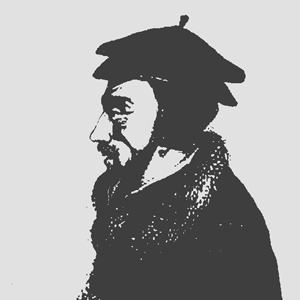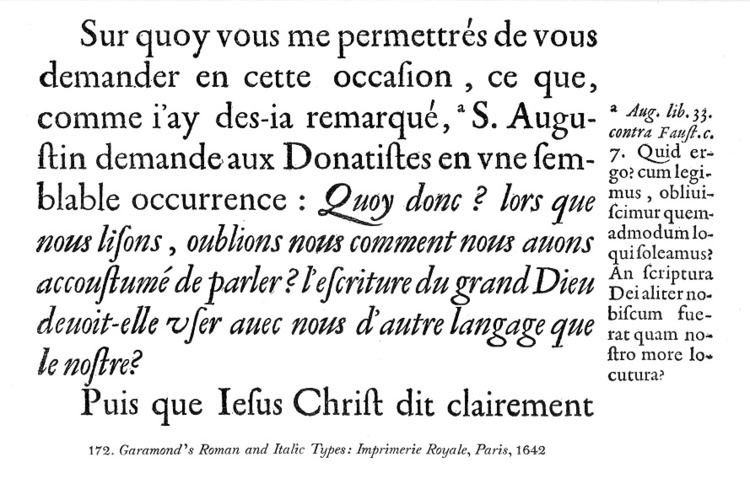Name Jean Jannon | ||
 | ||
Died December 20, 1658, Sedan, France | ||
Jean Jannon (born April 1580, Geneva; d. December 20, 1658, Sedan) was a French type designer, punchcutter and typefounder active in Sedan early in the seventeenth century. Jannon was a Protestant in mostly Catholic France, and established a career as printer for the Protestant Academy at Sedan in what is now north-eastern France before taking up punchcutting, in his thirties by his report. Sedan at the time enjoyed an unstable independence as a principality at a time when the French government had conceded through the Edict of Nantes to allowing a complicated system of restricted liberties for Protestants. Despite this, Jannon was commissioned in 1641 to provide matrices, moulds used to cast metal type, for the royal printing office. These matrices survive and remain in the government collection.
Contents

Jannon worked as a printer along with his career as a punchcutter, and in 1640 left Sedan for Paris. His career continued to meet with official hostility; four years later his printing office in Caen was raided by authorities concerned that he may have been publishing banned material. While not imprisoned, Jannon ultimately returned to Sedan and spent the rest of his life there.

Career

Jannon began his career as a printer, taking up engraving metal type quite late in life by the standards of the period, in his thirties by his report. Jannon wrote in his 1621 specimen that:

Seeing that for some time many persons have had to do with the art [of printing] who have greatly lowered it…the desire came upon me to try if I might imitate, after some fashion, some one among those who honourably busied themselves with the art, [men whose deaths] I hear regretted every day [Jannon mentions some eminent printers of the previous century]…and inasmuch as I could not accomplish this design for lack of types which I needed…[some typefounders] would not, and others could not furnish me with what I lacked [so] I resolved, about six years ago, to turn my hand in good earnest to the making of punches, matrices and moulds for all sorts of characters, for the accommodation both of the public and of myself.
Jannon was one of the few punchcutters active in early seventeenth century France. This is perhaps owing to an economic decline over the previous century and due to pre-existing typefaces made during the mid-sixteenth century saturating the market.
Garamond misattribution
Despite a distinguished career as a printer, Jannon is perhaps most famous for a long-lasting historical misattribution. In 1641, the Imprimerie royale, or royal printing office, purchased matrices, the moulds used to cast metal type, from him. By the mid-nineteenth century, Jannon's matrices formed the only substantial collection of printing materials in the Latin alphabet left in Paris from before the eighteenth century. The matrices came to be attributed to Claude Garamond (d. 1561), a revered punchcutter of the sixteenth century who was known to have made punches for the government in the Greek alphabet, albeit a century before the Imprimerie was established. The attribution came to be considered certain by the Imprimerie's director Arthur Christian. Doubt began to be raised by historian Jean Paillard in 1914, but he died in the First World War soon after publishing his conclusions and his work remained little-read.
Several early revivals of Jannon's type were made under the name of 'Garamond'. The mistake was finally disproved in 1926 by Beatrice Warde, based on the work of Paillard and her discovery of material printed by Jannon himself in London and Paris libraries.
'Garamond' fonts actually based on Jannon's work include Monotype Garamond, the version included with Microsoft Office, and Linotype's Garamond No. 3. František Štorm's 2010 revival, Jannon Pro, is one of the few modern revivals of Jannon's work released under his name.
Jannon cut far more types than those surviving in the Imprimerie collection: aside from the misattribution to Garamond, Jannon was particularly respected for his engraving of an extremely small size of type, known as Sédanoise, which was popular.
Caractères de l'Université
By the nineteenth century, Jannon's matrices had come to be known as the Caractères de l'Université (Characters of the University). The origin of this name is uncertain. It has sometimes been claimed that this term was an official name designated for the Jannon type by Cardinal Richelieu, while Warde in 1926 more plausibly suggested it might be a garbled recollection of Jannon's work with the Sedan Academy, which operated much like a university despite not using the name. Carter in the 1970s followed this conclusion. Mosley, however, concludes that no report of the term (or much use of Jannon's type at all) exists before the nineteenth century, and it may originate from a generic term of the previous century simply meaning older or more conservative typeface designs, perhaps those preferred in academic publishing.
